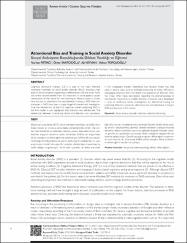| dc.contributor.author | Fıstıkçı, Nurhan | en_US |
| dc.contributor.author | Saatçioğlu, İbrahim Ömer | en_US |
| dc.contributor.author | Keyvan, Ali | en_US |
| dc.contributor.author | Topçuoǧlu, Volkan | en_US |
| dc.date.accessioned | 2019-08-31T12:10:23Z | |
| dc.date.accessioned | 2019-08-05T16:04:55Z | |
| dc.date.available | 2019-08-31T12:10:23Z | |
| dc.date.available | 2019-08-05T16:04:55Z | |
| dc.date.issued | 2015-03 | |
| dc.identifier.citation | Fistikci, N., Saatcioglu, O., Keyvan, A., & Topcuoglu, V. (2015). Attentional bias and training in social anxiety disorder. Noropsikiyatri Arsivi-Archives of Neuropsychiatry, 52(1), 4-7. doi:10.5152/npa.2015.8777 | en_US |
| dc.identifier.issn | 1300-0667 | |
| dc.identifier.issn | 1309-4866 | |
| dc.identifier.uri | https://hdl.handle.net/11729/1882 | |
| dc.identifier.uri | https://dx.doi.org/10.5152/npa.2015.8777 | |
| dc.identifier.uri | https://app.trdizin.gov.tr/makale/TVRrMk5EYzBOQT09 | |
| dc.description.abstract | Cognitive behavioral therapy (CBT) is one of the most effective treatment modalities for social anxiety disorder (SAD), showing a high level of clinical evidence supporting its effectiveness. On the other hand, lack of the desired benefit from this treatment in some patients causes continuation of the search for new techniques. Recent research studies have focused on attentional bias and attention training in SAD. Attention processes in SAD have been a major target of interest and investigation since the introduction of the first cognitive models explaining SAD. In the first model, it was highlighted that attention was self-focused. The relationship between threatening stimuli and attention was considered in the subsequent models. Attentional bias towards threat may take place in several ways, such as facilitated processing of threat, difficulty in disengaging attention from the threat and avoidance of attention from the threat. After these descriptions regarding the phenomenology of the disorder, treatments to modify attention, processes were developed. In spite of conflicting results, investigations on attentional training are promising. Attention processes, attentional bias and attentional training in SAD are discussed in this review. | en_US |
| dc.description.abstract | Bilişsel davranışçı terapi (BDT) sosyal anksiyete bozukluğunda (SAB ) kanıt düzeyi yüksek, en iyi sonuç alınan tedavi yöntemlerinden biridir. Öte yandan, bazı hastalarda bu tedaviden istenilen yararın elde edilememesi, yeni teknikler arayışının devamına neden olmaktadır. SAB'da son araştırmalar dikkat yanlılığına ve dikkat eğitimine odaklanmıştır. SAB'da dikkat süreçleri rahatsızlığın bir bilişsel bozukluk olarak açıklandığı ilk modellerden bu yana araştırmaların hedefi olmuştur. İlk modelde, dikkatin kişinin kendi üzerine odaklı olduğu vurgulanmıştır. Tehdit edici uyaranlar ve dikkat arasındaki ilişki daha sonraki modellerde kabul edilmiştir. Tehdite yönelik dikkat yanlılığı tehditin kolaylaştırılmış işlenmesi, dikkatin tehditten uzaklaştırılmasında zorlanma, dikkatin tehditten kaçırılması şeklinde oluşabilir. Hastalık süreci-ne getirilen bu açıklamalar sonrasında, dikkat süreçlerini değiştirmek için tedaviler geliştirilmiştir. Çelişkili sonuçlara rağmen, dikkat eğitimi araştırmaları ümit vericidir. Bu derlemede SAB'da dikkat süreçleri, dikkat yanlılıkları ve dikkat eğitimi konuları tartışılmıştır. | en_US |
| dc.language.iso | eng | en_US |
| dc.publisher | Turkish Neuropsychiatric Society | en_US |
| dc.relation.isversionof | 10.5152/npa.2015.8777 | |
| dc.rights | info:eu-repo/semantics/openAccess | en_US |
| dc.subject | Anxiety | en_US |
| dc.subject | Attention | en_US |
| dc.subject | Attention biases | en_US |
| dc.subject | Attentional training | en_US |
| dc.subject | Attentional bias | en_US |
| dc.subject | Avoidance behavior | en_US |
| dc.subject | Behavior therapy | en_US |
| dc.subject | Cognition | en_US |
| dc.subject | Cognitive therapy | en_US |
| dc.subject | Difficulty disengaging attention | en_US |
| dc.subject | Dot probe paradigm | en_US |
| dc.subject | Evidence based practice | en_US |
| dc.subject | Experimental test | en_US |
| dc.subject | Faces | en_US |
| dc.subject | Facial expressions | en_US |
| dc.subject | Human | en_US |
| dc.subject | Individuals | en_US |
| dc.subject | Modification program | en_US |
| dc.subject | Neuropsychological test | en_US |
| dc.subject | Phobia | en_US |
| dc.subject | Randomized controlled-trial | en_US |
| dc.subject | Recognition | en_US |
| dc.subject | Replication | en_US |
| dc.subject | Review | en_US |
| dc.subject | Social anxiety disorder | en_US |
| dc.subject | Social behavior | en_US |
| dc.subject | Social environment | en_US |
| dc.subject | Social phobia | en_US |
| dc.subject | Spatial cueing task | en_US |
| dc.subject | Stroop test | en_US |
| dc.subject | Threat | en_US |
| dc.subject | Dikkat | en_US |
| dc.subject | Dikkat eğitimi | en_US |
| dc.subject | Nörolojik bilimler | en_US |
| dc.subject | Psikiyatri | en_US |
| dc.subject | Sosyal anksiyete bozukluğu | en_US |
| dc.title | Attentional bias and training in social anxiety disorder | en_US |
| dc.title.alternative | Sosyal anksiyete bozukluğunda dikkat yanlılığı ve eğitimi | en_US |
| dc.type | review | en_US |
| dc.description.version | Publisher's Version | en_US |
| dc.relation.journal | Noropsikiyatri Arsivi | en_US |
| dc.contributor.department | Işık Üniversitesi, Fen Edebiyat Fakültesi, Psikoloji Bölümü | en_US |
| dc.contributor.department | Işık University, Faculty of Arts and Sciences, Department of Psychology | en_US |
| dc.identifier.volume | 52 | |
| dc.identifier.issue | 1 | |
| dc.identifier.startpage | 4 | |
| dc.identifier.endpage | 7 | |
| dc.peerreviewed | Yes | en_US |
| dc.publicationstatus | Published | en_US |
| dc.relation.publicationcategory | Makale - Ulusal Hakemli Dergi - Kurum Öğretim Elemanı | en_US |
| dc.relation.publicationcategory | Makale - Uluslararası Hakemli Dergi - Kurum Öğretim Elemanı | en_US |
| dc.contributor.institutionauthor | Saatçioğlu, İbrahim Ömer | en_US |
| dc.relation.index | WOS | en_US |
| dc.relation.index | Scopus | en_US |
| dc.relation.index | PubMed | en_US |
| dc.relation.index | TR-Dizin | en_US |
| dc.relation.index | Science Citation Index Expanded (SCI-EXPANDED) | en_US |
| dc.description.quality | Q4 | |
| dc.description.wosid | WOS:000351851100002 | |
| dc.description.pubmedid | PMID:28360667 | |


















